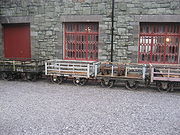
Slate waggon
Encyclopedia



Slate
Slate is a fine-grained, foliated, homogeneous metamorphic rock derived from an original shale-type sedimentary rock composed of clay or volcanic ash through low-grade regional metamorphism. The result is a foliated rock in which the foliation may not correspond to the original sedimentary layering...
. The characteristics of this stone led to the development of small open cars that carried the slate in its various forms. These were first developed on the narrow gauge railways serving the slate industry
Slate industry in Wales
The slate industry in Wales began during the Roman period when slate was used to roof the fort at Segontium, now Caernarfon. The slate industry grew slowly until the early 18th century, then expanded rapidly until the late 19th century, at which time the most important slate producing areas were in...
of North Wales
North Wales
North Wales is the northernmost unofficial region of Wales. It is bordered to the south by the counties of Ceredigion and Powys in Mid Wales and to the east by the counties of Shropshire in the West Midlands and Cheshire in North West England...
in the late 18th century. They were initially used on horse-drawn
Horsecar
A horsecar or horse-drawn tram is an animal-powered streetcar or tram.These early forms of public transport developed out of industrial haulage routes that had long been in existence, and from the omnibus routes that first ran on public streets in the 1820s, using the newly improved iron or steel...
tramways, but survived with only minor modifications into the days of locomotive
Locomotive
A locomotive is a railway vehicle that provides the motive power for a train. The word originates from the Latin loco – "from a place", ablative of locus, "place" + Medieval Latin motivus, "causing motion", and is a shortened form of the term locomotive engine, first used in the early 19th...
s and are still to be found in use in the 21st century.
Slate Waggon
This is the basic vehicle for transporting roofing slates from the quarryQuarry
A quarry is a type of open-pit mine from which rock or minerals are extracted. Quarries are generally used for extracting building materials, such as dimension stone, construction aggregate, riprap, sand, and gravel. They are often collocated with concrete and asphalt plants due to the requirement...
to the destination. Because roofing slates are relatively friable
Friability
Friability is the ability of a solid substance to be reduced to smaller pieces with little effort. The opposite of friable is indurated....
, they are packed vertically into the open slate waggons to reduce the chance they will be broken on their journey. Early designs used simple wooden rails to hold the packed slates. Later these were replaced with iron or steel railed examples of a similar design.
Slab Waggon
Slab waggons are designed to carry large uncut slabs of slate, often internally within quarries. The most common form is flat waggon (often referred to as a sled) where the slab is laid horizontally on wooden runners and chained to the wagon. A less common form is the vertical slab waggon, where two slabs are chained to an A-frame mounted on the wagon; this form of slab wagon was most famously used on the Corris RailwayCorris Railway
The Corris Railway is a narrow gauge preserved railway based in Corris on the border between Merionethshire and Montgomeryshire in Mid-Wales....
though other lines such as the Ffestiniog Railway
Ffestiniog Railway
The Ffestiniog Railway is a narrow gauge heritage railway, located in Gwynedd, Wales. It is a major tourist attraction located mainly within the Snowdonia National Park....
also had examples of this type.

